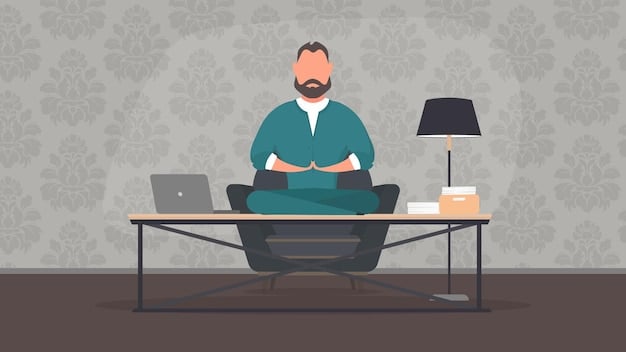Stop Multitasking: Boost Productivity by 25% with Single-Tasking

Stop multitasking and embrace single-tasking to significantly enhance your productivity; studies show that focusing on one task at a time can improve efficiency by up to 25%, reducing errors and improving overall performance.
Are you constantly juggling multiple tasks, feeling overwhelmed and unproductive? It’s time to stop multitasking and discover the power of single-tasking, a strategy that can boost your productivity by 25% or more. Let’s dive into how you can achieve more by doing less, one task at a time.
The Myth of Multitasking
Multitasking, often touted as a valuable skill, is actually a productivity killer. While it might seem like you’re accomplishing more by juggling multiple tasks, research shows that your brain isn’t designed to handle simultaneous focus. Instead, you’re rapidly switching between tasks, leading to reduced efficiency and increased errors.
What Science Says
Studies have consistently debunked the myth of multitasking. When you multitask, your brain must constantly reallocate resources, resulting in cognitive overload. This constant switching leads to mental fatigue, making it harder to concentrate and solve problems effectively. It’s like trying to listen to two conversations at once – you end up understanding neither.
The Impact on Cognitive Function
Multitasking negatively affects cognitive functions such as memory and attention. The constant interruption and redirection of focus can impair your ability to retain information and make sound decisions. Over time, chronic multitasking can even lead to a decline in cognitive performance, impacting your long-term productivity and mental well-being.
- Decreased Focus: Multitasking impairs your ability to concentrate on any single task effectively.
- Increased Errors: Rapid task switching leads to more mistakes and lower quality work.
- Mental Fatigue: Constant reallocation of cognitive resources results in mental exhaustion and burnout.
- Reduced Creativity: Multitasking hinders creative thinking, as your brain doesn’t have the space to explore innovative ideas.
In conclusion, the notion that multitasking boosts productivity is a misconception. By recognizing the detrimental effects of multitasking on cognitive function and overall efficiency, you can begin to shift towards single-tasking, a strategy proven to enhance focus, reduce errors, and foster a more productive work environment.

Benefits of Single-Tasking
Single-tasking, the practice of focusing on one task until completion before moving on to the next, offers numerous benefits for both your productivity and mental health. By eliminating the distractions and cognitive overload associated with multitasking, you can unlock a new level of efficiency and effectiveness.
Enhanced Focus and Concentration
When you dedicate your attention to a single task, you’re able to immerse yourself fully, leading to enhanced focus and concentration. This deep level of engagement not only improves the quality of your work but also reduces the time it takes to complete tasks. Without the constant interruptions of multitasking, you can maintain a steady and productive workflow.
Improved Quality and Accuracy
Single-tasking reduces the likelihood of errors and improves the overall quality of your work. By concentrating on one task at a time, you can pay closer attention to detail, ensuring that each task is completed accurately and thoroughly. This results in higher-quality deliverables and fewer revisions, ultimately saving time and resources.
- Increased Efficiency: Single-tasking allows you to complete tasks more quickly and efficiently.
- Reduced Stress: Eliminating task switching reduces mental clutter and stress.
- Better Retention: Focusing on one task at a time enhances memory and information retention.
- Greater Satisfaction: Completing tasks thoroughly leads to a sense of accomplishment and satisfaction.
In summary, embracing single-tasking can transform your work habits, leading to enhanced focus, improved quality, and reduced stress. By prioritizing one task at a time, you create a more efficient and enjoyable work environment, allowing you to achieve your goals with greater ease and satisfaction.
How to Implement Single-Tasking
Implementing single-tasking requires a conscious effort to change your work habits and create an environment that supports focused attention. By adopting practical strategies and techniques, you can successfully transition from multitasking to single-tasking and reap its numerous benefits.
Prioritize and Plan Your Tasks
Start by prioritizing your tasks and creating a detailed plan for the day. Identify the most important tasks and allocate specific time slots for each. This structured approach helps you stay focused and prevents the temptation to jump between tasks. Use tools like to-do lists and calendars to stay organized and on track.
Eliminate Distractions
Distractions are the biggest enemy of single-tasking. Minimize interruptions by turning off notifications, closing unnecessary tabs, and finding a quiet workspace. Communicate your need for uninterrupted time to colleagues and family members. Creating a distraction-free environment is essential for maintaining focus and maximizing productivity.
- Set Clear Goals: Define specific and achievable goals for each task.
- Use Time Blocking: Allocate specific blocks of time for focused work.
- Practice Mindfulness: Stay present and engaged in the task at hand.
- Take Breaks: Short breaks can help refresh your mind and prevent burnout.
In conclusion, transitioning to single-tasking is an achievable goal with the right strategies and mindset. By prioritizing tasks, eliminating distractions, and employing time management techniques, you can cultivate a work environment that fosters deep focus and sustained productivity. The shift to single-tasking not only enhances your efficiency but also promotes a greater sense of control and accomplishment in your daily work.

The Pomodoro Technique
The Pomodoro Technique is a popular time management method that can significantly enhance your ability to single-task. By breaking down your work into focused intervals with short breaks, you can maintain high levels of concentration and avoid the mental fatigue associated with multitasking.
How the Pomodoro Technique Works
The Pomodoro Technique involves working in focused 25-minute intervals, called “pomodoros,” followed by a 5-minute break. After every four pomodoros, take a longer break of 20-30 minutes. This structured approach helps you stay focused and prevents burnout by allowing for regular mental breaks. The key is to remain fully concentrated during each pomodoro and avoid distractions.
Benefits of the Pomodoro Technique
The Pomodoro Technique offers several advantages, including improved focus, enhanced time management, and increased accountability. By working in short, focused bursts, you can maintain high levels of concentration and avoid the mental fatigue that can lead to multitasking. The regular breaks help you recharge and stay motivated throughout the day.
- Increased Focus: Short, focused intervals enhance concentration.
- Better Time Management: Structured time allocation improves productivity.
- Reduced Procrastination: Short bursts of work make tasks less daunting.
- Enhanced Motivation: Regular breaks help maintain motivation and prevent burnout.
In summary, the Pomodoro Technique is a valuable tool for implementing single-tasking and improving overall productivity. By working in structured intervals and taking regular breaks, you can maintain high levels of focus, avoid mental fatigue, and achieve your goals more efficiently. This technique not only enhances your time management skills but also promotes a healthier and more sustainable work routine.
Mindfulness and Single-Tasking
Mindfulness, the practice of being fully present in the moment, can significantly enhance your ability to single-task. By cultivating a heightened awareness of your thoughts and actions, you can reduce distractions and stay focused on the task at hand.
The Role of Mindfulness
Mindfulness helps you recognize and manage distractions, allowing you to stay grounded in the present moment. By observing your thoughts and emotions without judgment, you can prevent your mind from wandering and maintain your focus on the task at hand. This heightened awareness enables you to work with greater intention and effectiveness.
Practical Mindfulness Techniques
Incorporate mindfulness into your daily routine by practicing simple techniques such as deep breathing, meditation, and mindful observation. Start with short mindfulness exercises and gradually increase the duration as you become more comfortable. These practices can help you develop a greater sense of calm and focus, making it easier to single-task effectively.
- Deep Breathing: Take slow, deep breaths to calm your mind and enhance focus.
- Meditation: Practice daily meditation to cultivate a greater sense of inner peace.
- Mindful Observation: Pay attention to your thoughts and emotions without judgment.
- Present Moment Awareness: Focus on the current task without anticipating future events.
In conclusion, incorporating mindfulness into your single-tasking routine can lead to significant improvements in focus and productivity. By cultivating a heightened awareness of your thoughts and emotions, you can reduce distractions and maintain a steady concentration on the task at hand. Mindfulness not only enhances your work performance but also promotes overall mental well-being, creating a more balanced and fulfilling life.
The Right Tools and Environment for Single-Tasking
Creating the right environment and utilizing appropriate tools are essential for successfully implementing single-tasking. A conducive workspace and effective software can significantly enhance your ability to focus and maintain productivity.
Optimize Your Workspace
Your workspace should be clean, organized, and free from distractions. Ensure that you have all the necessary materials within reach and that your environment promotes a sense of calm and focus. Consider using noise-canceling headphones, ergonomic furniture, and natural lighting to create an optimal working environment.
Utilize Productivity Tools
Leverage productivity tools to help you stay organized and on track. Use task management apps, calendar reminders, and note-taking software to prioritize tasks and manage your time effectively. These tools can help you streamline your workflow and prevent the temptation to multitask.
- Task Management Apps: Use tools like Todoist or Asana to organize and prioritize tasks.
- Calendar Reminders: Set reminders for important deadlines and appointments.
- Note-Taking Software: Use Evernote or OneNote to capture ideas and manage information.
- Website Blockers: Use apps like Freedom to block distracting websites and apps.
In summary, optimizing your workspace and utilizing productivity tools are vital for successful single-tasking. By creating a distraction-free environment and leveraging software to manage your workflow, you can enhance your focus and maintain high levels of productivity. The right tools and environment not only support your work habits but also contribute to a more enjoyable and fulfilling work experience.
| Key Point | Brief Description |
|---|---|
| 🎯 Focus | Enhances concentration and reduces errors. |
| ⏱️ Time | Improves time management and efficiency. |
| 🧘 Mindfulness | Promotes mental well-being and reduces stress. |
| 🎧 Environment | Optimizes workspace for better concentration. |
FAQ Section
▼
Single-tasking involves focusing on one task at a time until completion, while multitasking is attempting to handle multiple tasks simultaneously. Single-tasking aims for deep focus and higher quality, while multitasking often leads to decreased efficiency and increased errors.
▼
Yes, studies show that focusing on one task at a time can significantly enhance productivity. By reducing mental fatigue and improving concentration, individuals can complete tasks more efficiently and accurately, leading to an approximate 25% increase in productivity.
▼
Start by prioritizing your tasks and creating a schedule. Eliminate distractions, set clear goals for each task, and use time management techniques like the Pomodoro Technique. Practice mindfulness to stay present and focused on the task at hand.
▼
Various tools can assist with single-tasking, including task management apps (e.g., Todoist), calendar reminders, note-taking software (e.g., Evernote), and website blockers (e.g., Freedom). These tools help you stay organized, manage your time, and minimize distractions.
▼
Mindfulness helps you stay grounded in the present moment by increasing awareness of your thoughts and emotions. This awareness reduces distractions and allows you to maintain focus on the task at hand, leading to improved concentration and increased productivity.
Conclusion
In conclusion, embracing single-tasking is a powerful way to boost productivity and enhance your overall well-being. By prioritizing focus, eliminating distractions, and utilizing effective tools and techniques, you can unlock your full potential and achieve your goals with greater ease and efficiency. Make the shift today and experience the transformative benefits of single-tasking.





